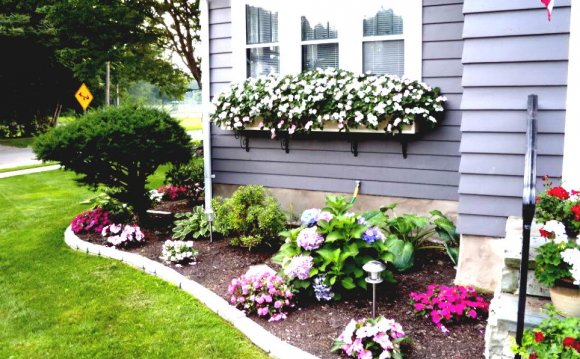
Homeowners can quickly tire of the way their yard is landscaped – or maybe not even landscaped at all. Everyone wants a pretty, well-kept yard that looks planned. So what if you’ve never landscaped before? Many people are scared to try it themselves, thinking that landscaping is best left up to professionals. Good news: it’s not!
There are plenty of simple ways to spruce up a yard long-term and change the topography of your front or back yard. You don’t have to be an expert on landscape design or what looks good – just try something basic. A little bit of landscaping, even simple, can dramatically change the look of your residence and add a little “pizazz” to a lackluster lawn.
During the warm summer months, consider giving your yard a facelift with one or several of the easy ideas below. These are great beginner landscaping ideas because they don’t require prior experience or any advanced techniques.
If you’re new to landscaping and need some beginner-level ideas that you can complete yourself, you don’t have to start out right away with a stone walkway or a goldfish pond. Consider simpler ideas that you can bring to life without too much hassle.
Fill side yards with landscape material, such as pea gravel or sand. A smooth, full look in these areas will look nice to the eye and give your yard a more polished look. Often dirt-filled side yards and empty beds can accumulate weeds, so if you don’t want to plant flowers there, gravel or sand can be an easy option that doesn’t require constant watering or weeding. If you have old logs or crumbling bricks sectioning off these areas, consider replacing these with new brick or rock for a fresh look.
Choose a focal point. Lots of good, simple designs start with one big item – a tree, a shrub (or series of shrubs), or a hardscape item like an arch, bench, or sculpture. Consider where you might put one larger item, and then let the rest of the yard’s design flow from there. Often one big item will guide the rest of your design! If your yard already has a large item, work with it to enhance or direct eyes to the item in question. If it doesn’t, consider adding one – planting a tree or putting a decorative item in an area of your lawn you want to highlight.
Create a flower bed. If you’re unsure of where to begin with your grand-scale garden ideas, start with one new flower bed – maybe around your mail box, under a window, or beside the house. Then experiment with what plants – like perennials or flowering shrubs – work well in that location based on the level of sun and shade and the soil quality in that spot. When choosing plants to put in your flower bed, you can always lean on the expertise of the employees at the home and garden store. They will be able to guide you to the plants that will thrive best in your location. Once you’ve watched your flower bed flourish, you can consider adding more – or maybe just stick with one! One flower bed is more manageable than a whole yard of flower beds, so starting small can be helpful for beginners.
Plant native plants. If you choose to plant native plants that grow naturally in your region, you’ll have less expense and maintenance because native plants thrive without help. If you feel wary of the time it will take to cultivate fancy flowers or plants, consider native plants as a starting point. Grasses and native bushes can actually be interesting and enjoyable to look at, just as much as flowers.
Add fresh mulch to flower beds and garden areas. A bold, dark new mulch will protect your plants and prevent weed growth with the added benefit of a homogenous, clean look. Fresh mulch is such an easy landscaping fix, but it always gives your yard a more put-together look – and once you have the mulch spread nice and thick, it will often last a year or more before you have to mulch again.
The change a simple design can make to a yard can be huge. Even small ideas like these can spruce up a front or back yard. You don’t have to be an expert to landscape. All you need are a few basic ideas to get you started, and some good supplies.















